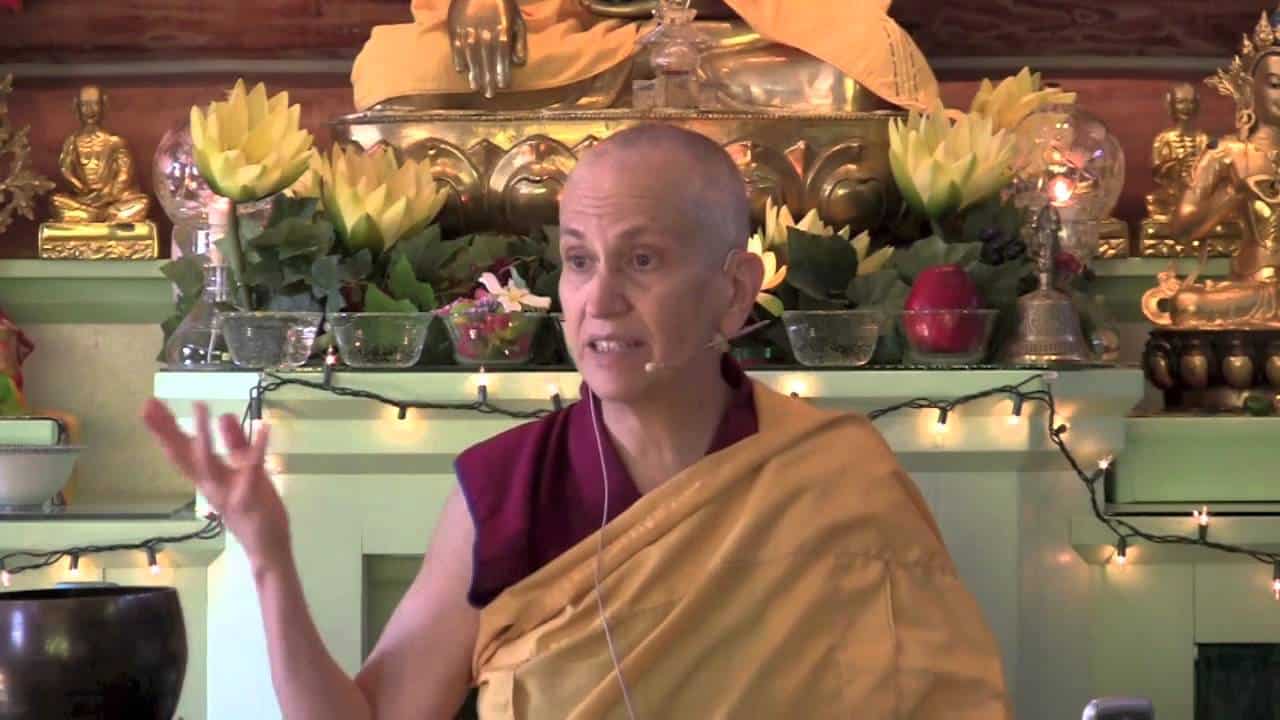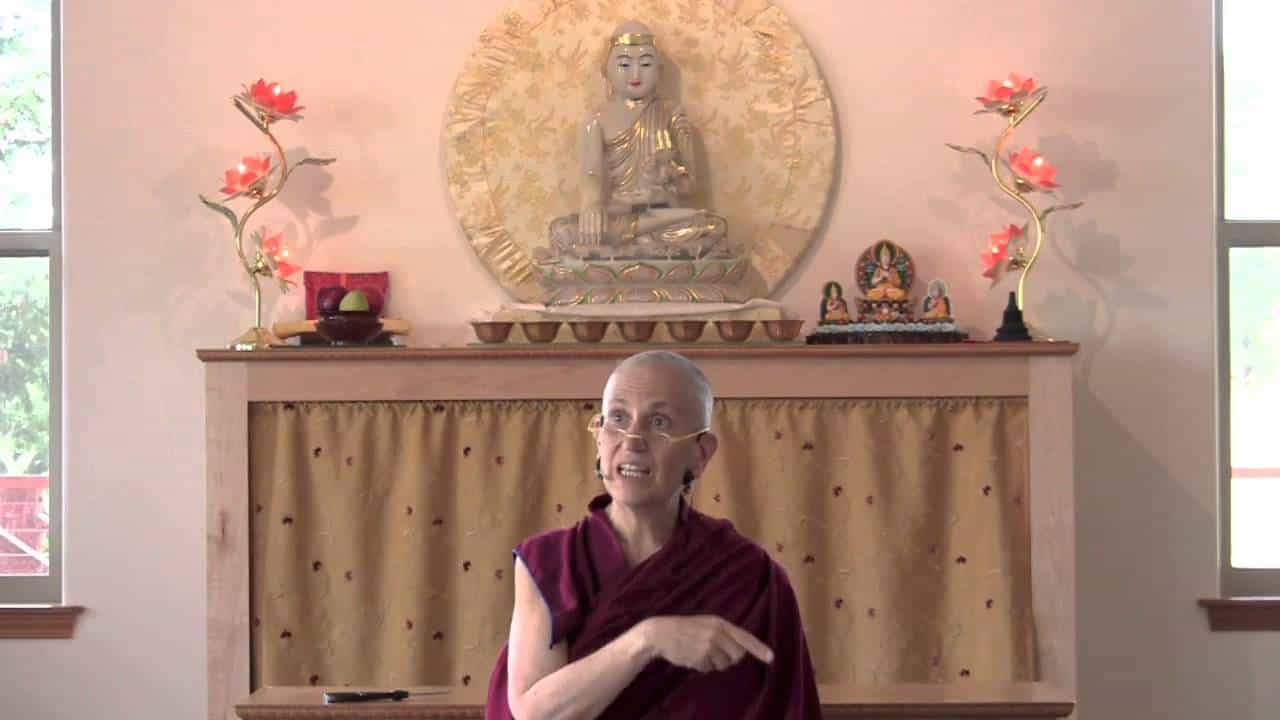Emptiness and buddha nature
Part of a series of teachings on the text The Essence of a Human Life: Words of Advice for Lay Practitioners by Je Rinpoche (Lama Tsongkhapa).
- The eight qualities of the Buddha listed in Maitreya’s Treatise on the Sublime Continuum
- How the qualities of the Three Jewels center around emptiness
The Essence of a Human Life: Emptiness and buddha nature (download)
The text we’ve been going through by Je Rinpoche is designed for lay practitioners, and we’re on the verse that talks about taking refuge that you do as a result of reflecting on the karma we’ve created and where that’s likely to project our next rebirth.
I wanted to talk a little bit more about what the Three jewels are. In the Tara retreat we went into some depth about that using the explanation in Maitreya’s Sublime Continuum, so I thought that I would review that very simply now so that people would have that and so that people who are newer to the Dharma would get some idea of what the Buddha, Dharma, and Sangha Jewels actually are, because the whole thing centers around emptiness and the realization of emptiness. When you look at what the Buddha, Dharma, Sangha are it has to do with realizing emptiness, which is the true path, and then using that direct realization to eliminate the defilements from the mind, which are the true cessations. And then that gives you the qualities of the Buddha, Dharma, and Sangha Jewels.
We’ll just go through it very briefly. It’ll be a good review for the people who had it in the Tara retreat, and maybe we’ll spark interest in the people who weren’t in the Tara retreat to watch the longer explanations from that retreat.
The Buddha Jewel, as described in The Sublime Continuum (gyü lama). The verse says:
Unconditioned and spontaneous,
not realized by other extraneous conditions,
Possessing knowledge, compassionate love, and ability
Buddhahood has the qualities of the two benefits (for self and others).
The first of the eight qualities is the excellent quality of being unconditioned. This indicates that the Buddha’s truth body, by its very nature, possesses a natural purity and is free from inherent existence—ever has been, ever will be—completely free of inherent existence.
The second one is the excellent quality of being spontaneous. Whereas the first one was the natural purity, that the truth body has never been inherently existent, this one, the spontaneous, indicates that the truth body is also free of the adventitious afflictions, or adventitious defilements. That means that it’s the emptiness of the mind that has removed all of the defilements. It’s still emptiness, just like the natural purity, but it’s coming at emptiness from a different perspective, this time from it being the emptiness of the mind that has completely eliminated all defilements.
The third quality is not being able to be realized by extraneous conditions. What this means is that the Buddha’s realization—in this case the Buddha’s wisdom truth body that knows the ultimate nature—cannot be described in words. It’s something that has to be experienced by yourself, for yourself. The words point the directions on how to realize it, but it’s not something that can be conceptualized. Because this wisdom knows the emptiness of inherent existence directly, and has merged with that emptiness, they say like water poured in water—undifferentiatable.
The fourth quality is the excellent quality of knowledge. This is the Buddha’s omniscient wisdom that knows all the variety of phenomena, and especially all the dispositions and inclinations of sentient beings. This is a very important kind of wisdom that the Buddha employs in knowing how to guide sentient beings—who has what kind of karma, who has what kind of interest and predisposition, and so on.
The fifth quality is the Buddha’s loving kindness. This is another quality of the Buddha’s omniscient mind, the wisdom truth body, and this quality of compassionate love is the quality that enables the Buddha to reach out and benefit sentient beings, the motivating force behind it. But the Buddha doesn’t really have any motivation because everything from the Buddha is habitualized during the whole bodhisattva path. It’s not like the Buddha needs to exercise some effort to have compassion for sentient beings.
The sixth quality is the excellent quality of power, or ability, to liberate sentient beings. From the Buddha’s side he has the whole range of ability and methods to teach sentient beings so that sentient beings can liberate themselves. This one of power (or ability) is not saying that the Buddha is omnipotent. If the Buddha were omnipotent and could remove us from dukkha and cyclic existence the buddhas already would have done that. They have power, but it’s not omnipotence. If you have a being that’s omnipotent and could stop suffering, but they’re not doing it, it doesn’t make much sense. This power of the Buddha is from the Buddha’s own side, the ability to lead sentient beings.
The seventh quality is the excellent quality of one’s own welfare. That means that the Buddha has been able to accomplish his own purpose, which is eliminating all the defilements from his or her own mind. This encompasses, actually, the first three qualities of being unconditioned, spontaneous, and not being able to be realized by extraneous conditions.
The eighth quality is the excellent quality of others’ welfare, meaning that the Buddha has gained all the abilities to be of the greatest benefit to others, so this includes the 4th, 5th, and 6th qualities of knowledge, compassionate love, and power.
Those are the eight qualities of the Buddha Jewel. Tomorrow we’ll do the Dharma, and the day after, the Sangha Jewel.
Venerable Thubten Chodron
Venerable Chodron emphasizes the practical application of Buddha’s teachings in our daily lives and is especially skilled at explaining them in ways easily understood and practiced by Westerners. She is well known for her warm, humorous, and lucid teachings. She was ordained as a Buddhist nun in 1977 by Kyabje Ling Rinpoche in Dharamsala, India, and in 1986 she received bhikshuni (full) ordination in Taiwan. Read her full bio.


